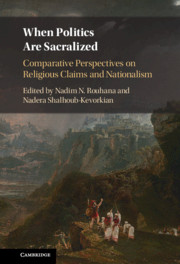Book contents
- When Politics Are Sacralized
- When Politics Are Sacralized
- Copyright page
- Contents
- Figures
- Maps
- Tables
- Contributors
- Preface and Acknowledgments
- 1 A Comparative Perspective on Religious Claims and Sacralized Politics
- Part I Israel
- Part II India
- Part III Sri Lanka
- Part IV Serbia
- Part V Iran
- Part VI Saudi Arabia and Wahhabism
- 11 Saudi Nationalism, Wahhabi Daʿwā, and Western Power
- Part VII Northern Ireland
- Part VIII Palestine
- Index
- References
11 - Saudi Nationalism, Wahhabi Daʿwā, and Western Power
from Part VI - Saudi Arabia and Wahhabism
Published online by Cambridge University Press: 10 June 2021
- When Politics Are Sacralized
- When Politics Are Sacralized
- Copyright page
- Contents
- Figures
- Maps
- Tables
- Contributors
- Preface and Acknowledgments
- 1 A Comparative Perspective on Religious Claims and Sacralized Politics
- Part I Israel
- Part II India
- Part III Sri Lanka
- Part IV Serbia
- Part V Iran
- Part VI Saudi Arabia and Wahhabism
- 11 Saudi Nationalism, Wahhabi Daʿwā, and Western Power
- Part VII Northern Ireland
- Part VIII Palestine
- Index
- References
Summary
This chapter examines how the rise of populist nationalism in Saudi Arabia interacts with Wahhabism and the role of Western power in controlling the outcome of this interaction. As a result of its founding agreement, the Saudi ruling family needs the support of Wahhabi clerks for internal legitimacy and of the West, mainly the US, for technological help and defense and security backing. These Saudi rulers have instrumentalized Wahhabism to advance a pan-Islamic ideology (da?wa) in an effort to fight rivals at home and combat Arab nationalism and liberal, socialist, and Marxist trends in the Arab region and Islamic societies. This ideology was also used to achieve global influence. The chapter explains that Saudi Arabia is a case in which an extreme interpretation of religious doctrine was needed to legitimize an authoritarian regime and ultimately became a tool of domestic governance and foreign policy.
- Type
- Chapter
- Information
- When Politics are SacralizedComparative Perspectives on Religious Claims and Nationalism, pp. 275 - 306Publisher: Cambridge University PressPrint publication year: 2021

